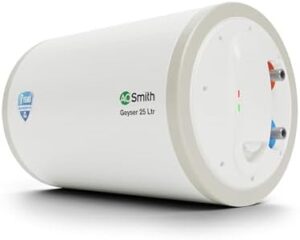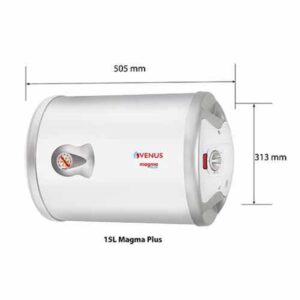Horizontal Geyser: How They Work & Why Choose Them
Introduction
There is only one type of water heater called a horizontal geyser. Houses constructed in the contemporary period are typically modest in size and designed to be energy efficient. The design of geysers may vary greatly, with some standing tall and others lying flat. This can be very helpful in homes that don’t have a lot of overhead room or that need certain fittings. This piece will explain how horizontal geysers work, explain why they’re popular, and give you reasons to think about getting one for your home.
What is a Horizontal Geyser?
A horizontal geyser is a type of water heater in which the tank lies flat on the ground rather than standing upright. This form is suitable for setups that require installation in tight or confined areas. Vertical geysers pose challenges in compact bathrooms or areas with limited ceiling height. Which is why they are often installed beneath tables. Regardless of the type of fountain, the primary function of the horizontal electric geyser is to heat water for home use efficiently.
How Does a Horizontal Geyser Work?
The way a horizontal geyser works is the same as the way a regular geyser works. From inside the tank, an electric heater raises the water to a certain level. The temperature at which water is stored for future utilization. It is, however, positioned differently from other tanks. Horizontal positioning affects the geyser’s heating element and temperature. The tank performs ideally for the situation.
- Heating Element: The components responsible for heating geysers are predominantly constructed from materials capable of withstanding elevated temperatures.
- Thermostat: Once the water temperature is reached, the timer deactivates the heater.
- Water Tank: This is because the heated water tank keeps the water warm for a longer amount of time using less energy.

Why Choose a Horizontal Geyser?
A horizontal geyser might be better than a vertical one for several reasons, including:
Space-Saving Design
Horizontal geysers work best in small areas or places where there isn’t much vertical room. A horizontal geyser may be put in low-ceilinged kitchens or tiny apartments. It fits under tables and in small locations.
Efficient Heat Retention
Because horizontal geysers are modest tank water is equally distributed. This improves heat retention reducing the need to reheat meals.
Aesthetic Appeal
Horizontal geysers tend to look cleaner and more modern, which can complement current home designs better.
Durability
High-quality materials minimize corrosion and wear on horizontal geysers extending their lifespan.
Easy Installation
A horizontal geyser is usually easier to install than a vertical one, especially when there is limited space or the placement point isn’t in the usual location.
Key Benefits of Horizontal Geysers
Better Space Utilization
People can use the space above or below the geyser because it is horizontal. This makes it perfect for small homes, apartments, or places with limited vertical space.
Energy-Efficiency
Many horizontal geysers have better protection than other types, which allows them to use less energy. This means that less energy is used, and the power price goes down.
Versatility in Placement
These geysers may be installed under basement or roof sinks. This simplifies house repair choices.

Common Issues and Solutions for Horizontal Geysers
There are some advantages to horizontal geysers, but they can be challenging to construct and require specialized care. This is a list of common problems:
- Pressure Loss: Horizontal geysers might have poor water flow if improperly constructed due to their internal structure.
- Solution: To guarantee appropriate installation and water flow adjustment, call a plumber for the best results.
- Insufficient Heating Time: According to some users, it may take a little longer for horizontal geysers to heat the water than for vertical ones.
- Solution: To speed up the heating process, consider a heater with higher power or more modern heating components.
- Space Considerations: Although these geysers are small, their horizontal orientation may require more space around them for installation, which could be a problem in certain situations.
- Solution: Carefully measure the space before purchasing to ensure it will fit perfectly.
Horizontal Geyser vs. Vertical Geyser: Which is Better?
Both types of geysers have their good points, but the one that you choose will rely on how much room you have and your family’s needs.
- Space: When there isn’t much vertical room or the roof is low, horizontal geysers work best. Conversely, vertical geysers require greater height but are utilized more frequently.
- Efficiency: When installed in a specific way, horizontal geysers may use slightly less energy because their heating system is more even.
- Cost: There is no significant price difference between horizontal and vertical geysers; however, due to their design, horizontal types are sometimes more expensive.
How to Choose the Right Horizontal Geyser for Your Home?
To pick the right horizontal geyser, you need to know what you want and how much room you have. Here are some essential things to think about:
- Capacity: Depending on how many people are in your family, pick a waterfall that can hold enough water. Generally, sizes range from 15L to 50L.
- Energy Rating: Find a pump that has a high grade for how well it uses energy. It will use less electricity if the grade is better.
- Brand and Warranty: Pick a name with a good reputation that backs up its guarantee with excellent customer service. This gives you peace of mind in case something goes wrong.
- Installation: Ensure that a professional installs the geyser to avoid potential problems with leaks or poor performance.
Conclusion
Horizontal geyser are a good way to heat water in modern homes because they occupy little space, use minimal energy, and are aesthetically pleasing. A horizontal geyser can be a great choice if you don’t have much vertical room, want to save money on your energy bills, or want a small water heating system.
Frequently Asked Questions (FAQs)
What distinguishes horizontal and vertical geysers?
Horizontal geyser are ideal for under-counter or low-ceiling installations, as they lay flat in rooms with low ceilings. In contrast vertical geysers which are erect may be too tall.
Can I place a horizontal geyser anywhere?
Maintaining a constant water flow and pressure is essential when installing straight geysers. So that it heats the most efficiently and uses the least amount of energy.
Are horizontal geysers more energy-efficient than vertical ones?
Because they distribute heat evenly over the tank, horizontal geysers may save energy in some systems. They also have superior insulation, which keeps the heat in longer and reduces the need for reheating.
How do I maintain a horizontal geyser?
Maintenance for horizontal geysers is identical to that for vertical geysers. Check for leaks, clean the tank to remove sediment, and test the heating element and thermostat. To maximize performance, have a professional service your geyser yearly.
5. How long does a horizontal geyser last?
A well-maintained horizontal geyser can last 8–12 years, depending on the brand and usage.